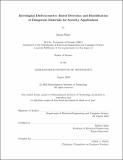Interdigital dielectrometry based detection and identification of dangerous materials for security applications
Author(s)
Sears, Jason, 1978-
DownloadFull printable version (14.64Mb)
Other Contributors
Massachusetts Institute of Technology. Dept. of Electrical Engineering and Computer Science.
Advisor
Markus Zahn.
Terms of use
Metadata
Show full item recordAbstract
Recent terrorist threats have increased the attention paid to searching airline passengers for dangerous and explosive materials. In particular, the possibility that terrorists might hide explosives in shoes has prompted most airline screening stations to require that shoes be removed for x-ray inspection. This thesis is a preliminary investigation of an interdigital dielectrometry based method that could safely and accurately determine the material content within shoes while they are worn. Theoretical modeling of the sensor and the representative materials under test were conducted with the finite element analysis package Maxwell from Ansoft Corp. and analytic/numerical mathematical models for material property estimation. The studies show that dangerous materials hidden in the sole of a shoe could be detected and identified if they lie within the penetration depth of the sensor and if they are sufficiently different in their complex dielectric properties from the normal shoe material. Preliminary finite element computer simulations were also performed to show the effects of sensing electrode segmentation on improving the penetration depth of the electric field, but at the cost of reduced signal strength. Experiments using interdigital sensors with wavelengths ranging from 1 mm to 40 mm in the frequency range of 0.005 Hz to 10 kHz first on homogeneous materials such as air, sand, sugar, salt, wood, Lexan, Teflon, and paper and later on actual shoes with cavities containing foreign materials show that the materials can be identified based on their complex dielectric properties as extracted from experimental data using an inverse parameter solver for material property estimation. The ability of the dielectrometry system to precisely identify materials from a database is presently limited by measurement noise, contact quality and sample placement inconsistency. Likewise, variations due to moisture content and other contamination present challenges to future development of the technology.
Description
Thesis (S.M.)--Massachusetts Institute of Technology, Dept. of Electrical Engineering and Computer Science, 2003. Includes bibliographical references (p. 134-137). This electronic version was submitted by the student author. The certified thesis is available in the Institute Archives and Special Collections.
Date issued
2003Department
Massachusetts Institute of Technology. Department of Electrical Engineering and Computer SciencePublisher
Massachusetts Institute of Technology
Keywords
Electrical Engineering and Computer Science.